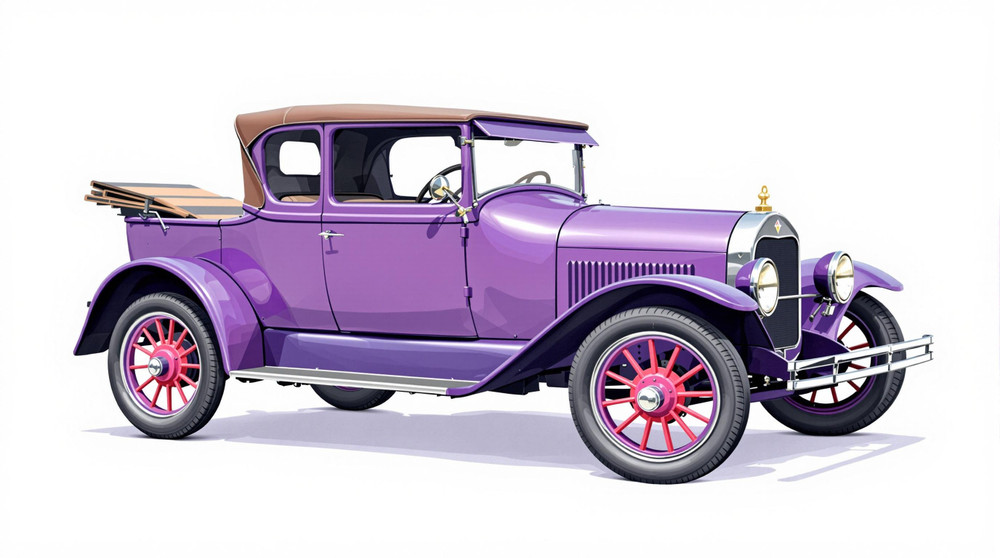Image of 1918 Dodge Model 30, Note: These illustrations use artistic license and may differ from actual historical models.
Performance Metrics
Fundamental Metrics
Emotional Appeal
MMP Rating
| Engine Specifications | |
|---|---|
| Engine: | Inline-4 |
| Displacement: | 212 cubic inches |
| Horsepower: | Estimated 35 HP |
| Torque: | Not available |
| Compression Ratio: | Not available |
| Ignition System: | Magneto |
| Cooling System: | Water-cooled |
| Performance Specifications | |
| 0-60 Time: | Not available |
| 1/4 Mile Time: | Not available |
| Top Speed: | 50 mph |
| Transmission and Drive | |
| Drive Type: | Rear-wheel drive |
| Transmission Type: | 3-speed manual |
| Fuel and Efficiency | |
| Fuel System Type: | Carburetor |
| MPG: | Not available |
| Dimensions and Brakes | |
| Brakes: | Mechanical drum brakes |
| Wheelbase: | 114 inches |
| Weight: | 2,400 lbs |
Note: Specifications for classic cars are given to the best of our ability, considering the limited and variant data available.
Unveiling the 1918 Dodge Model 30: A Pioneer of Its Time
The year 1918 marked a significant milestone in the automotive industry with the introduction of the Dodge Model 30. Crafted by the Dodge Brothers, John and Horace, who were once key suppliers to Ford, this vehicle emerged as a testament to their expertise and vision. The Model 30 was not just another car; it was a symbol of innovation during an era where transportation was undergoing a profound transformation. What made this car stand out was its all-steel body construction, a pioneering feature that set a new standard in automobile manufacturing.
Design and Innovation: The Art of the Dodge Model 30
The exterior of the Dodge Model 30 exuded strength and durability with its robust steel body—a novelty at the time. Its design was both functional and stylish, featuring clean lines and an imposing grille that commanded attention. Inside, the vehicle boasted high-quality materials that offered comfort and sophistication to its occupants. The use of real wood and finely crafted upholstery spoke volumes about the attention to detail that went into each car. Technological advancements were at the heart of the Model 30. It featured a 12-volt electrical system, which was quite advanced for its time, providing more reliable starting and lighting compared to the 6-volt systems commonly used. Color options were limited in those days, but Dodge offered choices that resonated with the tastes of the era. Among these, dark blue and olive green were particularly popular. The Model 30 came in various body styles including touring, roadster, sedan, and coupe versions. The touring body style, with its open-air design and ample seating, became an iconic representation of early automotive freedom.
Historical Significance: The Legacy of the Model 30
The Dodge Model 30's impact on automotive design cannot be overstated. It was one of the first mass-produced cars to feature an all-steel body, which greatly improved passenger safety and vehicle durability. This innovation eventually became an industry standard. Moreover, it set itself apart from competitors with features like a sliding gear transmission and a water-cooled engine, which contributed to its reputation for reliability and performance.
Performance and Handling: Experiencing the Drive
In terms of performance, the Model 30's 35 horsepower engine may not impress by modern standards, but at the time it provided ample power for everyday driving. Top speed figures hovered around 50 mph—a respectable pace for vehicles in that period. Handling was straightforward with a sturdy suspension system that managed to absorb most road imperfections. Driving a Model 30 was an engaging experience; from the distinctive sound of its four-cylinder engine to the tactile feedback through its thin steering wheel. Drivers felt connected to the road in a way that modern cars often insulate against.
Ownership Experience: Life with a Dodge Model 30
Owners of the Dodge Model 30 used their vehicles for everything from daily commuting to leisurely Sunday drives. Its reliability made it suitable for regular use while its distinctive character also made it a favorite among early auto enthusiasts. Maintenance on these vehicles is relatively straightforward by today's standards but requires some mechanical know-how given their age. Parts can be scarce but there is a dedicated community around these vintage Dodges that support restoration and maintenance efforts.
Fun Facts: Did You Know?
The Dodge Model 30 holds its place in history with some unique stories. For instance, it was one of the first cars to climb Pikes Peak successfully. While celebrity ownership wasn't as highlighted back then as it is today, several high-profile individuals of the era chose Dodge as their preferred mode of transport. Criticism at the time centered around its relatively higher price compared to competitors like Ford's Model T; however, many justified the cost with its superior build quality and features.
Collector's Information: The Value of History
Today, finding a 1918 Dodge Model 30 can be quite a challenge as production numbers were not as vast as later mass-produced models—estimates suggest several thousand were made. Their value can vary significantly based on condition, originality, and history; prices can range from $10,000 for a project car up to $50,000 or more for well-restored examples. As for appreciation potential, well-preserved or expertly restored examples of the Dodge Model 30 have seen steady appreciation over time due to their historical significance and rarity.
Conclusion: Celebrating Automotive Heritage
The 1918 Dodge Model 30 stands as an enduring piece of automotive history—a testament to early twentieth-century innovation and craftsmanship. It represents an era when cars transitioned from novelties to necessities and showcases how far we've come in terms of automotive design and technology. Owning or even experiencing one today offers a rare glimpse into our past on four wheels.
1918 Dodge Model 30 Catalog of Parts
 1918 Dodge Model 30 Step Plate Pad. Rubber face only. 4-1/4" O.D. Each-SP 18Step Plate Pad. Rubber face only. 4-1/4" O.D. Each
1918 Dodge Model 30 Step Plate Pad. Rubber face only. 4-1/4" O.D. Each-SP 18Step Plate Pad. Rubber face only. 4-1/4" O.D. EachWhy Choose Metro?
For over 100 years, Metro Moulded Parts has been the pinnacle of quality in classic car restoration parts. Our commitment to precision and authenticity in every component ensures a perfect fit and an OEM-level appearance.
- Expert Craftsmanship & Quality: Each part is a testament to our dedication to reliability and perfection, crafted from original designs and thoroughly tested.
- Advanced Technology: We use cutting-edge techniques to create flawless, long-lasting parts that surpass others in performance.
- SuperSoft Sponge – The Ultimate Door Seal: Not only are our door seals 30% softer than competitors', but they're also guaranteed to never leak. They effectively reduce wind and road noise, enhancing your classic car's comfort and driving experience.
- Proudly American: Our parts are a product of American craftsmanship, made in the USA with a spirit of excellence and heritage.
- Unrivaled Warranty: We back our products with a 30-year industry-leading warranty, a testament to our confidence in their quality.
Join us in preserving the legacy of classic cars with parts that are crafted for perfection, not just made.

